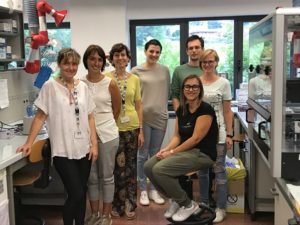Article No. 438
6 June 2021

Marina ( left ) with some of the team in Bergamo
Another ERKNet webinar was presented on June 1st by Dr Marina Noris.
Marina is a very well known aHUS researcher at the Mario Negri Institute in Bergamo , Italy. The webinar was recorded and has been made available on the ERKNet website , click HERE.
Marina began her talk “atypical Haemolytic Uraemic Syndrome” with an explanation of its thrombotic microangiopathy (TMA) links and its rare prevalence among all TMAs. She stated that sometimes there may be no renal involvement!
An explanation of Complement’s role and the key part played by C3 and its impact on the damaging parts and controllers of this part of the immune system ,and other things, like antibodies,that hamper controllers’ effectiveness. Also the loss of function and gain of function that can take place in leading to disease.
The genetic findings that explain a predisposition to aHUS have been the result of European research over 20 years or more.
These findings may only explain 60% of aHUS incidence, however. Other important research has shown that patients may be at more risks because they have multiple rare genetic mutations or a more common risk modifying genetic difference ( haplotype/ polymorphism ) .
A simple step time line of the disease process was presented from illness onset through to eculizumab treatment prescription and possible withdrawal and relapse. This led to illustrating a risk classification( high to low) of genetic mutations, or not having any, including in a transplant scenario.
Marina challenged the audience to decide on a diagnosis of a patient , giving clinical blood results evidence. She moved on to other blood markers of complement activation, particularly HMEC1.
This test, although it has been around for a while, seems to gets very little attention because it currently can only be performed in three laboratories (avoidance of contamination and specialist equipment and skills are paramount). It has been tested in vitro for its specificity and sensitivity using health volunteers and aHUS patient in an active or remissive state. It can be used to test that complement has been fully blocked by the treatment therapy, by checking for C5b9 deposition on the endothelial cells. It may have predictive uses for those in remission.
Marina called it “A Disease a Dish” in the summing up of her talk.
For those needing a swift , comprehensive and up to date overview of the disease aHUS in less than hour, this talk is highly recommended.

